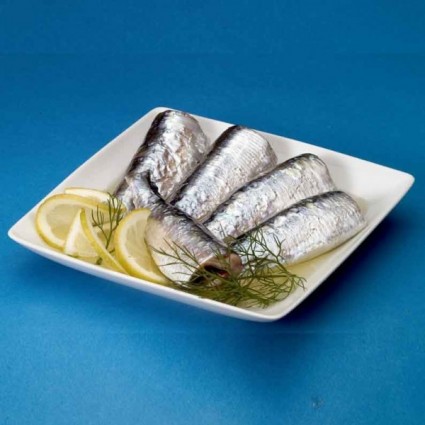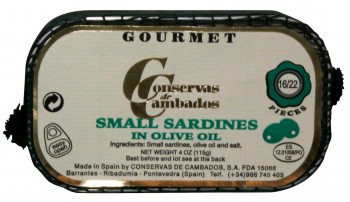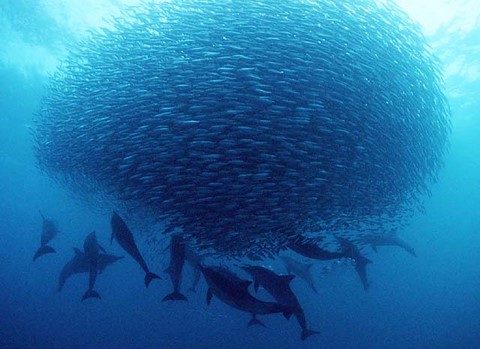Holy cow! I mean fish! Due to the high mercury levels in most fish, the savvy Modern Paleo dieter should pass on mercury-toxic larger fish and eat low mercury sardines! Hands down, sardines are the safest fish on the planet.
With growing concern over the health of the seas, people are turning to sardines for the essential nutrients found in fish. Sardines are at the bottom of the aquatic food chain, feeding solely on plankton. As a result, they do not concentrate as much heavy metals like mercury and other contaminants found in most fish. Why not? They don’t live long enough to accumulate too much mercury. They live as long as 14 years of age, but about 90 percent of the population is under 6 years old.
Labeling laws are not standardized in America and many other regions regarding small canned fish. More than 20 varieties of fish are sold as sardines around the world, including herring (Americas), pilcards (Mediterranean), brisling (Norway), sprat (New Zealand, Australia, Europe) and Iwashi (Japan). Sardines are abundant in the seas of the Atlantic, Pacific and Mediterranean with Spain, Portugal, France, and Norway being the leading producers of canned sardines.
Sardines are also one of the most sustainable fish around. The Monterey Bay Aquarium’s Seafood Watch program lists sardines as a “Best Choice” due to their abundance and high production rate. Sardines are all wild. They are not farmed, as the life cycle of the sardine does not lend itself to farming. Maybe in years to come some scientist may crack the sardine code, but not yet. Sardines are also sustainably fished and do not put pressure on the planet’s fisheries.
I recommend people eat 3-4 cans of sardines a week. I much prefer eating fish than supplementing fish oil. I am not the biggest fan of the purified fish oils most people supplement (purified fish oil is less absorbable). Eating small fish like sardines is the way to go to meet one’s omega-3 needs.
Do Sardines Make You Gag?
Not to fear! You just ate some nasty sardines. There are good quality and bad quality sardines, just like any other food. You may want to give sardines another chance with a better brand.
Some of the poor quality brands (which does not always translate into the cheapest brand), taste extra fishy and even have an off, bitter taste to me. The higher quality brands taste like tuna and do not have that fishy taste. I mean, they taste like fish, but don’t taste fishy. See a list of brands I like below.
Why Eat Sardines?
Sardines pack a nutritional punch! A typical serving (one can) of sardines packed in olive oil contains around 14 grams of protein, 168 calories and 14.4 grams of fat, with 2.4 grams of the fat being saturated. Most of the fat content in sardines stems from polyunsaturated and monounsaturated fats, which may help to lower cholesterol levels and prevent heart disease. Here are a few more reasons to chow on sardines:
 Omega-3. Many people today are deficient in omega-3, an essential fatty acid we must consume in the diet. Sardines are one of the most concentrated sources of the omega-3 fatty acids EPA and DHA. One can of sardines actually contains 1.5 grams of Omega-3.
Omega-3. Many people today are deficient in omega-3, an essential fatty acid we must consume in the diet. Sardines are one of the most concentrated sources of the omega-3 fatty acids EPA and DHA. One can of sardines actually contains 1.5 grams of Omega-3. - Calcium. The bones in sardines are rich in calcium. One can contains 350 mg of relaxing calcium.
- Selenium. The silvery skin of sardines is rich in selenium. Most people are deficient in this vital mineral needed to make thyroid hormones.
- Phosphorus. This mineral is important to strengthen the bone matrix that holds the bone’s minerals.
- B12. Sardines have one of the highest concentrations of B12 of any food, enjoying over 8 mcg in a single can.
- Vitamin D. Sardines contain about 175 IU of vitamin D. Not bad, but not nearly close enough to my recommended 5000 IU a day.
- Iodine. A can of sardines contains 35 micrograms of iodine, but read the nutrition facts label, since different varieties of sardines may vary slightly in iodine content.
- Trace Minerals. Sardines are from the sea and contain all of the sea’s bounty of trace minerals, desperately needed by everyone.
- RNA and DNA. These nucleic acids are proteins needed to rebuild body tissues.
Mercury
You should be worried about mercury in fish. Most medium to large sized fish and shellfish, even wild-caught, are full of mercury and should be avoided for the most part. I didn’t say completely, but caution is warranted. Seafood, especially shellfish, are contaminated with heavy metals like mercury, lead, other toxic metals and industrial wastes like polychlorinated biphenyls (PCBs) and pesticides. These toxins become concentrated in older fish, large predatory fish, and in fatty species of fish.
The small size and shorter life span of the sardine means that it has less time to accumulate mercury. All larger fish can concentrate mercury up to a million times more than sardines! Sardines contain low levels of mercury (less than 216 ppb) and PCBs (less than 11 ppb). (1)
Learn more about why you should be eating mostly small fish in my Seafood Survival Guide.
There is some debate that the selenium in fish binds to mercury to remove it from the body. I think there is merit to this, however, this does not account for the other metals and toxins in fish. It also does not account for people who’s detox pathways cannot get rid of mercury for various reasons – selenium or no. And then there are those who are allergic to mercury. Even small amounts can make them ill when another person is not bothered by high amounts. There are tremendous health benefits to fish, but I think it prudent to restrict your diet to smaller fish like sardines and occasionally enjoy larger fish, perhaps once a week or more infrequently.
How to Buy
There’s a lot of variety and choice within your sardine purchase.
Organic. Organic only refers to the ingredients other than fish, like mustard or olive oil.
Packed with flavor? Avoid sardines with stuff like Maltodextrin, Acetic Acid, Modified Cornstarch, Xanthan Gum, Polysorbate 80, Artificial Color, and Artificial Flavor. These are usually in sardines in mustard, tomato or other sauces. Read the ingredient list!!!
Packed in Water. Fish packed in water may be best avoided. They are not comparable in quality to fish packed in oil, but I would rather you buy sardines in water than a cheap unhealthy oil like soybean or canola oil.
Packed in Oil. The best sardines are packed in olive oil. They are a better quality that don’t need sauces or spices to mask flaws. If the fish are packed in oil, be sure it’s either olive oil or fish oil. SKIP the fish packed in canola or other inflammatory omega-6 oil. This defeats the whole purpose of eating sardines – the omega-3! Heavier oils (like soybean oil) are too stable and won’t hold onto the flavor, especially with the smoked varieties.
Season. Sardines have seasonal food supplies and are at their fattiest in the late summer and autumn. So if your tin or can has packaging dates this is good information for deciding on a brand.
Fresh. You can find fresh sardines at some fish markets. Good luck finding them! Fresh sardines need to be gutted and rinsed under cold running water. Look for ones that smell fresh, are firm to the touch, and have bright eyes and shiny skin.
Live. Short of a can, if you live near an active fishing community, a scoop of live bait is your best deal. Depending on the location, a 5-8 lb scoop will cost between $15-30 and provide LIVE sardines generally of a greater size. Grill em up!
Skinless and Boneless. Can’t tolerate sardines? It might be the skin and bones. A few of my clients can tolerate the boneless and skinless sardines much better. So, if you can’t tolerate ’em, join ’em and get the skinless and boneless. Or skin them yourself. Bonus: the boneless and skinless have up to 50% less mercury. Why? Mercury concentrates in the brain and spinal cord, so if the bones are removed along with the spinal cord, so is some of the mercury.
Smoked. Smoking adds some flavor to these little fish. They are smoked so that they can be cooked without the omega-3 fatty acids “weeping” out of the meat. Beware: Some canneries put liquid smoke in the tin before canning.
Gluten-free. Most sardines are gluten-free, except for some brands packed in tomato and mustard sauce, which use thickeners.
Frozen. Some sardines are first frozen before being canned. It’s impossible to tell from the label which varieties are frozen before canning, but my guess is that the sardines that are not intact within the tin are likely frozen before canning. This is my list of distributors that I believe use frozen sardines from time to time:
- Roland
- Ocean Prince
- Chicken of the Sea
- Rugenfisch
- Crown Prince
- Reese
How to eat ’em
- Straight outta the can.
- On a gluten free cracker.
- On a blue corn chip.
- If you’re feeling really antisocial put some slivers of onion on there, too.
- Sardines on toast recipe: Gluten-free bread, mayo/avocado, sardines, sliced hardboiled eggs, thinly sliced onion, thin slices of tomato, capers, salt and pepper.
- Make a ‘tuna’ fish salad. Mash them with a fork with mayonnaise. Add chopped pickles, onion or celery if you like.
- Grill ’em and put ’em in a taco.
- Sprinkle sardines with lemon juice and extra virgin olive oil.
- Combine sardines with chopped onion, olives and fennel.
- Top sardines with chopped tomatoes and basil, oregano, or rosemary.
- Balsamic vinegar gives sardines a nice zing.
- Make a sauce with extra virgin olive oil, lemon juice, pressed garlic, Dijon mustard, and salt and pepper. Serve over sardines.
Recommended Brands
 In terms of taste, price does not matter. There are plenty of good, cheap brands. Some brands are frankly disgusting. And unfortunately this is many people’s initiation into sardines that makes them vow to never eat another one. Free yourself of this mistaken belief! Here are my top picks guaranteed to convert you:
In terms of taste, price does not matter. There are plenty of good, cheap brands. Some brands are frankly disgusting. And unfortunately this is many people’s initiation into sardines that makes them vow to never eat another one. Free yourself of this mistaken belief! Here are my top picks guaranteed to convert you:
Conservas De Cambados – These are my absolute favorite!! Sardines are already small, but these are small sardines (think less mercury). Good luck buying them. The store is in Spanish. They are sold on Amazon, but brace yourself for the price.
Cole’s Sardines – Cole’s is an earth-friendly company dedicated to selling the finest, foods from around the globe. Love their products.
Vital Choice – Amazing sustainable fish shop – without the fish market stank.
Angelo Parodi – They are carried at most Italian markets or delis.
Sardine Pageant
Not all sardines are created equal. For my tastes, Sardines from Spain and Portugual are the best. They have more of a tuna taste than most with a firm quality. I would say that sardine quality can pretty much be determined by country of origin with the following ranking:
 Italy
Italy- Portugal
- Spain
- Morocco
- Norway
- France
- Scotland
- Canada
- Poland
- USA
- The Philippines
- Thailand
- Mexico
If you’re one of those people that are convinced you don’t like sardines, I beg you to give them another chance with a better brand. I bet you a million micrograms of mercury that you’ll be pleasantly surprised with the brands I’ve recommended in this article. Give them another shot.









